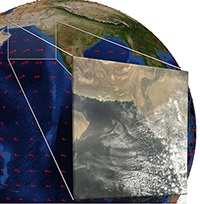March 2014
Indian Monsoon Reacts to Deserts' Whims
Study shows distant desert dust strengthens Asian summer monsoon

The satellite image shows features of the Earth that are playing a role in the remote link between dust and Indian monsoon rainfall. This study shows that atmospheric heating induced by light-absorbing dust can modify winds that transport moisture from the ocean into India, where it falls as monsoon rainfall. The influence on monsoon rainfall over India occurs within a week. The clear sky, true-color globe image of the region is courtesy of NASA's Blue Marble project, with vectors (arrows) indicating summer winds (from the NASA MERRA Reanalysis). A blow-up of the North Arabian Sea region shows an example of dust to the west, and clouds to the east. (July 15, 2006 satellite image by Jesse Allen,
NASA Earth Observatory).
Enlarge image.Results: In a new study published in Nature Geoscience, a research team led by Dr. Phil Rasch at Pacific Northwest National Laboratory found that desert dust plays a hand in intensifying the summer Asian monsoon rainfall. The study shows that dust in the air absorbs sunlight west of India, warming the air and strengthening the winds carrying moisture eastward, translating to more monsoon rainfall about a week later in India.
"The strength of monsoons has been declining for the last 50 years," said Rasch, chief scientist for climate at PNNL and corresponding author of the paper. "We found that dust plays a role in strengthening the monsoon, although this natural phenomenon does not overpower other influencing effects such as temperature differences between land and ocean, land use changes, and the local effect of pollution around India."
Why It Matters: India heavily relies on summer monsoon rains for the yearly fresh water supply. Even small changes to the summer monsoon can have a large impact on crop yields, and through extended droughts or floods. Monsoons also influence the global circulation affecting weather and climate in distant regions. This paper shows that natural airborne particles can influence rainfall in unexpected ways, with changes in one location rapidly affecting weather thousands of miles away.
"The difference between a monsoon flood year or a dry year is about 10 percent of the average summer rainfall in central India," said Rasch. "Variations driven by dust may be strong enough to explain some of that year-to-year variation."
Methods: PNNL's Rasch, V. Vinoj of the Indian Institute of Technology Bhubaneswar, India who worked with Rasch as a postdoctoral fellow, and their coauthors wanted to explore a correlation that appeared in satellite records: higher amounts of small particles called aerosols over North Africa, West Asia, and the Arabian Sea seemed to be connected to stronger rainfall over India around the same time. The team tried to verify this and determine how those particles might affect rainfall.
With the Community Atmosphere Model (CAM5), they explored this connection by including manmade aerosols from pollution, and natural sea salt and dust aerosol particles. The simulations showed a similar connection-more aerosols in the west translated to more rainfall in the east. When they systematically turned off the contribution of each aerosol type, they found that dust was the condition that showed a stronger rainfall connection in India as a result of increased dust from North Africa and the Arabian Peninsula.
The team then ran shorter simulations to determine how quickly dust worked. They found that after turning off dust in the model, dust dissipated within a week compared to the simulation with dust, and rainfall declined in central India as well, indicating that the dust effect happens over a short period of time.
To learn more, see PNNL news release "The rush to rain."
Acknowledgements
Sponsors: The research was supported by the PNNL Laboratory Directed Research and Development program and the U.S. Department of Energy 's Office of Biological and Environmental Research Earth System Modeling
's Office of Biological and Environmental Research Earth System Modeling program.
program.
Research Team: Phil Rasch, Hailong Wang, Jin-Ho Yoon, Po-Lun Ma and Balwinder Singh, PNNL; and V Vinoj and K Landu, Indian Institute of Technology Bhubaneswar .
.
Research Area: Climate & Earth Systems Science
Reference: Vinoj V, PJ Rasch, H Wang, J-H Yoon, P-L Ma, K Landu, and B Singh. 2014. "Short-term Modulation of Indian Summer Monsoon Rainfall by West Asian Dust ." Nature Geoscience, advance online. DOI:10.1038/NGEO2107.
." Nature Geoscience, advance online. DOI:10.1038/NGEO2107.
另則新聞(台灣醒報)
【台灣醒報記者范捷茵綜合報導】別小看空氣懸浮粒子,它竟能影響遙遠地區的氣候!一份發表在《自然地球科學》期刊的研究發現,在西亞、北非揚起的空氣灰塵,會影響印度的夏季降雨量。這份報告不但解釋印度夏季降雨量的差異,更有助於修正氣候預測模型,讓降雨量預測更準確。
很多人知道空氣懸浮微粒的增加,會造成霾害空汙,近年來氣候研究學家也發現,空氣懸浮粒子增加後,因為空氣凝結核過多,在水氣量不變的前提下,每個凝結核分配到的水氣很少,使平均水珠變小,不易落到地面,但它們在集結後則容易增加一地降雨強度,使暴雨機率增加。
16日發表於《自然地球科學》期刊的研究更指出,空氣懸浮微塵能跨地區影響其他地區氣候,此研究的發布修正過去全球氣候監控模型;氣候研究科學家羅序表示,研究發現使科學家可以理解印度季風降雨量不均的現象,解釋為何雨量差異可以高達20%。
研究人員首先注意到空氣懸浮粒子與降雨量之間的關聯性,發現當西亞、北非懸浮粒子濃度高,印度地區降雨量會增加。接著他們以電腦模擬逐項檢視各因素,發現空氣微粒是關鍵因子。以電腦模擬方式加入大氣溫度、水氣變項後,研究人員認為,空氣微粒之所以會增加降雨量,是因為散佈在空氣中的灰塵吸收陽光輻射,進而暖化大氣溫度,而暖空氣能吸收更多水氣,使吹入印度的夏季季風水氣更充足。
透過氣候模擬亦發現,這種影響非常快速,阿拉伯海、阿拉伯半島、西亞的微塵對印度降雨量的影響,一星期內就看得到。研究中的懸浮粒子,不只包括工業灰塵、硝酸鹽等人為空氣汙染,也包括自然懸浮微粒,如海鹽、火山灰,和沙漠揚起的塵灰。


 字體:小 中 大
字體:小 中 大



 's Office of Biological and Environmental Research
's Office of Biological and Environmental Research 





